Bobolink
(Dolichonyx oryzivorus)
Conservation • Description • Habitat • Ecology • Distribution • Taxonomy
Conservation Status |
|||
| IUCN Red List | LC - Least Concern |
||
| NatureServe | N5B - Secure Breeding SNRB - Unranked Breeding |
||
| Minnesota | not listed Species in Greatest Conservation Need |
||
Description
Size
Total length: 6″ to 8″
Wingspan: 11½″
Voice
A bubly, metalic song with 25 to 50 notes lasting about 3½ seconds.
Similar Species
Habitat
Open grasslands
Ecology
Migration
Late April to early October
Nesting
Food
Distribution
Occurrence
Common migrant and breeder
Maps
The Minnesota Ornithologists’ Union All Seasons Species Occurrence Map
Taxonomy
Class
Aves (birds)
Order
Passeriformes (perching birds)
Family
Icteridae (New World blackbirds and orioles)
Genus
Dolichonyx (bobolinks)
Subordinate Taxa
Synonyms
Fringilla oryzivora
Visitor Photos
Share your photo of this bird.
This button not working for you?
Simply email us at info@MinnesotaSeasons.com.
Attach one or more photos and, if you like, a caption.
Dan W. Andree |
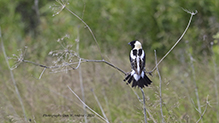 |
Bobolink balancing on a branch in the wind.... It first had both feet clamped on the left side branch but the wind was brisk and made it sway so much it decided to put one on each side to help balance itself while it perched briefly. Taken at a Prairie Preserve in Norman col Mn. June 2020. It would flick its wings at times and tail feathers to balance itself while the wind blew. Interesting color markings. Bobolinks make nice sounds and nice birds. |
Lynn Rubey |
||
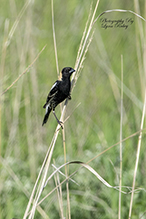 |
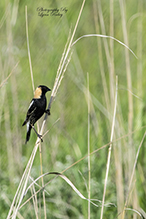 |
|
Breeding male Bobolink the only North American bird to have a white back and black under parts, he flew up to the grass sang for a few minutes looking around then flew back down to the ground in The Big Stone National Wildlife Refuge. |
Breeding Male Bobolink in this photo the straw colored patch on back of the head is clearly visible, as he balanced himself on some dried native prairie grass in The Big Stone National Wildlife refuge. |
|
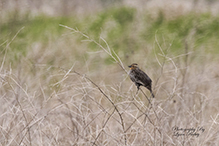 |
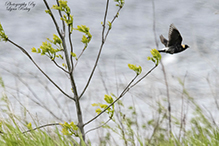 s s |
|
A female or non-breeding male Bobolink in the native prairie fields of The Big Stone National Wildlife Refuge. |
A breeding male Bobolink in flight along the Minnesota River. |
|
MinnesotaSeasons.com Photos
|

Slideshows
Bobolink
Allen Chartier
Bobolink
JMC Nature Photos

Visitor Videos
Share your video of this bird.
This button not working for you?
Simply email us at info@MinnesotaSeasons.com.
Attach a video, a YouTube link, or a cloud storage link.
Other Videos
Bobolink
The Music of Nature
Bobolink-Richland, OR-060311.mp4
Christopher Christie
Bobolink Portrait
ebirdr
Bobolink in Maine
WIld Bird Video Productions

Visitor Sightings
Report a sighting of this bird.
This button not working for you?
Simply email us at info@MinnesotaSeasons.com.
Be sure to include a location.
Dan W. Andree
June 2020

Location: Northern Tallgrass Prairie NWR, Pavia Unit, Norman Co. Mn.
It first had both feet clamped on the left side branch but the wind was brisk and made it sway so much it decided to put one on each side to help balance itself while it perched briefly. Taken at a Prairie Preserve in Norman col Mn. June 2020. It would flick its wings at times and tail feathers to balance itself while the wind blew. Interesting color markings. Bobolinks make nice sounds and nice birds.
Dave Zelinsky
5/20/2020
Location: Carver Park Preserve, Victoria, MN
Lynn Rubey
5/23/2019
Karen T.
5/15/2019
Location: Saint Francis, MN
David Ayer
7/11/2012
Location: Joseph A. Tauer Prairie SNA
MinnesotaSeasons.com Sightings

